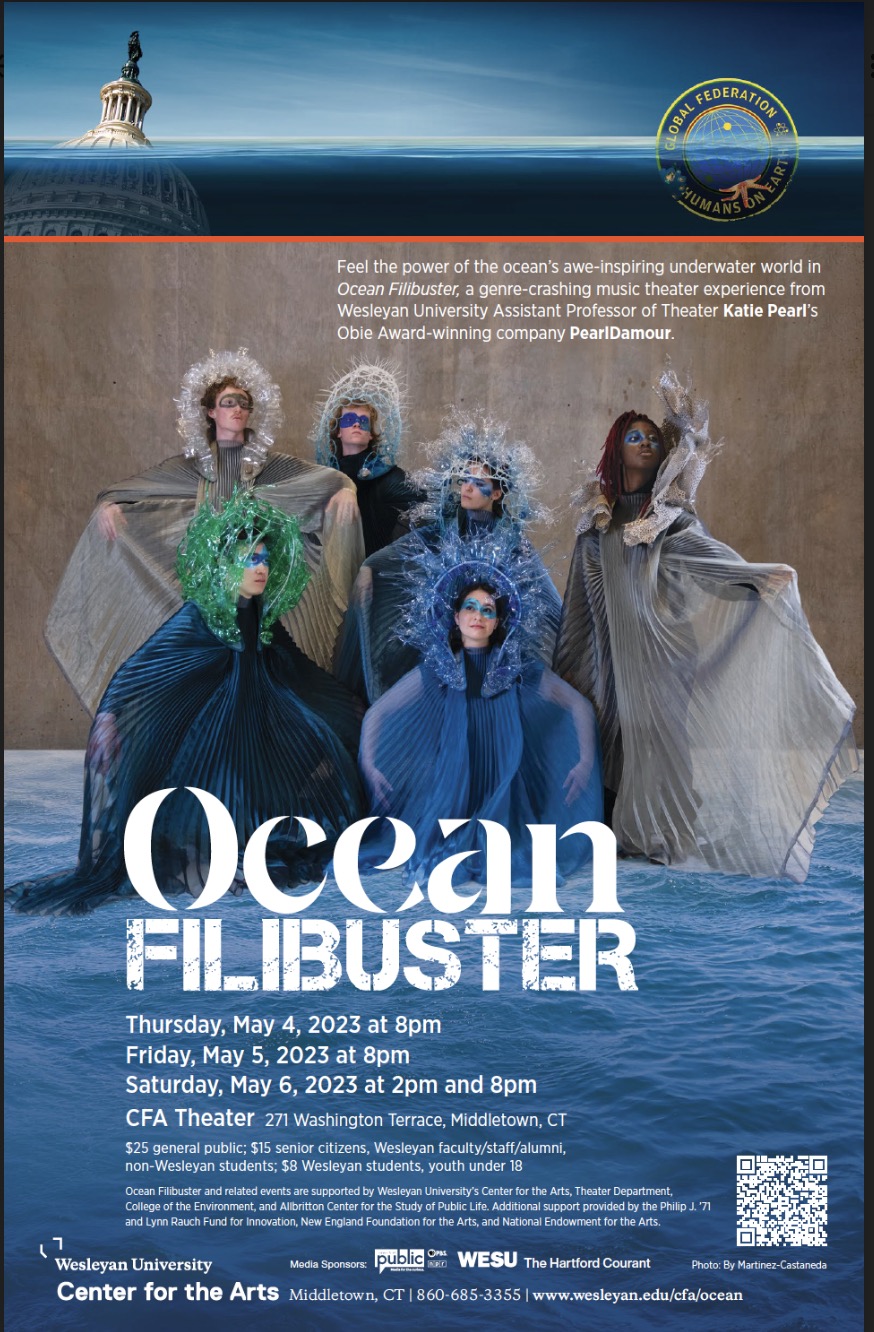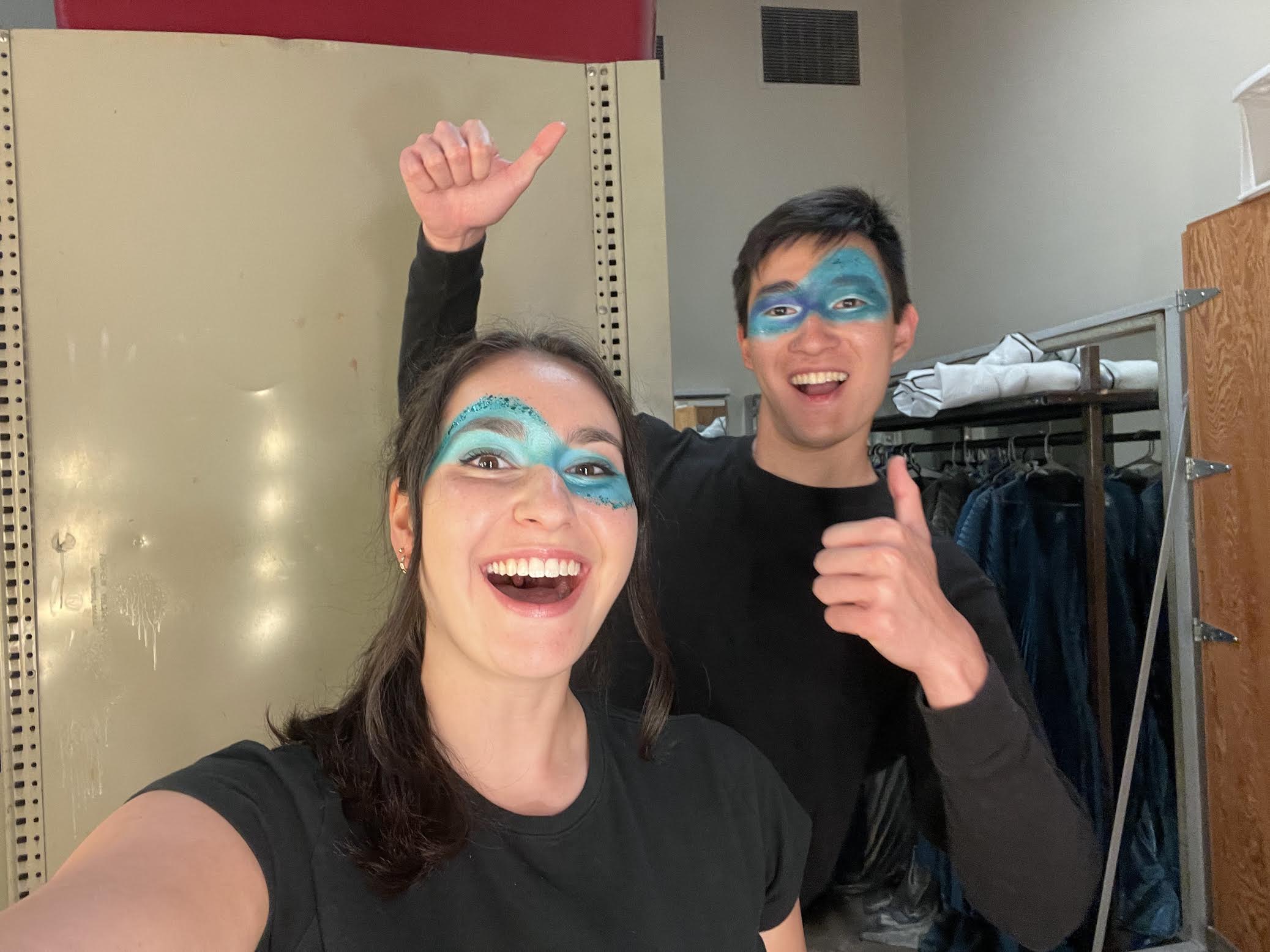
c/o CFA Theater
“Ocean Filibuster,” an original musical created by Lisa D’Amour, Sxip Shirey, and Assistant Professor of Theater Katie Pearl went up in the Center for the Arts Theater on Thursday, May 4 at 8 p.m., Friday, May 5 at 8 p.m., and Saturday, May 6 at 2 p.m. and 8 p.m. Upon entering the performance space, the audience is welcomed into a future global senate called the Global Federation For Humans on Earth. There, they meet the narcissistic Mr. Majority (Jennifer Kidwell) who proposes—or rather, advertises— the “End of Ocean Bill” which would shrink the world’s oceans down into manageable and marketable lagoons. When the floor is opened up for debate, the Ocean (also Kidwell) in human form takes center stage and begins to filibuster against the bill. Through catchy music, captivating projections, and compelling acting, “Ocean Filibuster” asks the audience to reflect on their connection with the ocean, and how we can save it from this future.
Walking into the theater, I was greeted by a sterile white stage with a podium in the center. Behind the podium was a screen with the Global Federation seal projected onto it, with newsroom-type music playing all around. Periodically, cliché phrases like “We see you. We hear you. We embrace you,” and “Harmonious Strength, Collaborative Wisdom” flashed across the screen. After the opening remarks by Mr. Majority’s assistant (Evan Spigelman), Mr. Majority walks on stage, gives his opening spiel, and recognizes Ocean to filibuster. He tells Ocean that she must speak continuously for the next 15 hours and must stay on topic.
Something unique about “Ocean Filibuster” is that it bridged Pearl’s professional theatrical career with her teaching job at the University. Two of the actors in the eight-member cast were played by professional actors who have been a part of Ocean Filibuster since it premiered in late 2022. Kidwell, one of the professional actors, was absolutely stunning on stage. She seamlessly switched between Mr. Majority and Ocean, changing the pitch of her voice and putting her bright red glasses on and off when the two characters were having a conversation. Spigelman, the other professional actor, in addition to playing Mr. Majority’s assistant, was also a member of the ensemble alongside the six Wesleyan students. I loved the interactions between Kidwell and Spigelman, especially in the beginning when Mr. Majority was giving his opening speech and his assistant was frantically running around making sure that Mr. Majority had what he needed.
The Wesleyan student ensemble assumed the role of protesters at the beginning of the show, then later transformed into extensions of Ocean herself. While these roles were significantly smaller in comparison to the roles of the two professionals, the students were captivating in their ocean costumes and sang beautifully alongside Kidwell and Spigelman. Before the show started, I was approached by both Oluchi Chukwuemeka ’26 and Cecily (Sissi) Foldessy ’26 asking me, in character, to sign petitions to support the Ocean. During Act I, Mr. Majority interrupts Ocean, giving a first reprimand during her filibuster with the reasoning that she was going off-topic (when she obviously wasn’t). The protesters, who are scattered throughout the audience, stand up and start yelling at Mr. Majority. They make their way down to the stage chanting “stand with the ocean,” where they are violently removed from the premises. They reappear towards the end of Act I, dressed in veil-like dresses, elaborate headpieces made from plastic bottles, and gorgeous eye makeup that sparkled in the light. Moving swiftly, the ensemble engulfed the stage and then spoke in unison in a singsong voice.
Pearl discussed how the Wesleyan ensemble let her understand the show better.
“[It was] full and multilayered and sort of, like, kaleidoscopic,” Pearl remarked. “I understand the show so much better now than I did when we were premiering it. I feel like during our premiere, so much of it was me staring at the stage, trying to figure out who these incredibly dressed, bizarre, beautiful creatures were. With this team, because they were such great singers during rehearsal, we didn’t have to spend a lot of time needing to practice and re-practice pitches and harmonies. It meant that we could kind of be in the song and find new choreography for them to do.”
Ensemble member Danielle Nodelman ’24 described the process from the students’ perspective.

c/o Danielle Nodelman ’24
“The process was very grounded in the natural cycles and observations we find in marine ecosystems,” Nodelman wrote in a message to The Argus. “Our rehearsals began with lots of learning, including reading Undrowned: Black Feminist Lessons from Marine Mammals by Alexis Pauline Gumbs, and we also had the opportunity to meet with guest artists who were similarly collaborating with nature in their own artistic work. Personally, my favorite parts were learning the music (with our wonderful music director Katie Fletcher ’25) and staging the choreography.”
One piece of the whole experience that I really loved was the four interactive exhibitions during intermission. Initially, I made my way backstage into the “Thermohaline Rave” filled with pump-up music, strobe lights, and three dancing ensemble members. From there, I followed the crowd into the “Oceanic Journey” which took place in TST001. The Theater Studio has been transformed into an oceanic maze, and the audience was asked to “clean up the ocean” by picking up recyclables and disposing of them at the end. As I made my way through the maze, I noticed the ocean-ness of the exhibition diminishing. The first piece of the maze contained plants made out of pool noodles, blue tissue paper strung together and hung from the ceiling, and blue LED lights casting shadows of swirls on the blue reef constructed on the walls. By the end, the walls were no longer blue, but were rather walls of plastic bags strung together. Though, what was really impactful was when you disposed of the recycling at the end, you just threw it back into earlier parts of the maze. This was done to illustrate the idea that most of the plastic that you recycle really just goes back into the ocean.
The other two exhibitions were at the front of the theater. The first was “See the Sea Floor,” where audience members could look at the bottom of the sea floor using an app on an iPad that some of the cast members were carrying. I got to see the skeleton of a blue whale and the thermal heat vents that come up as a result of global warming. “Meet Your Local River” depicted Liang Liang ’26 as the Coginchaug River, and we had to remove bits of trash that were clipped to the blue outfit she was wearing in order to “clean up the river.”
Act II began with improvisation by Kidwell, followed by a few group songs. One moment that stood out was during the last 30 minutes of the filibuster when there was a one-on-one discussion between Mr. Majority and Ocean. The two characters get into a heated debate that ends with the ocean ensemble crowding around Mr. Majority, whispering over and over, “you are me.”
At the end of the show, Mr. Majority gives Ocean a third reprimand with four seconds left on the clock. The ensemble is ushered off stage and in a moment of quick change, they re-enter in a matter of minutes as the protestors. Through their motions, it is implied that they are retaliating against Mr. Majority and the police officers while Ocean is whisked off stage. Everyone freezes, and the house lights come on. The ensemble takes their positions around the auditorium and begins passing phrases of a song to each other around the circle, beginning and ending with the phrase “the whale calls its mate.”
Through its interactive style, “Ocean Filibuster” invites the audience into a world where the ocean isn’t seen as an equal entity on this earth next to humans. We see how Ocean fights for her time to speak, sharing knowledge of her vastness and the creatures that live within her. We see how she is interrupted multiple times by Mr. Majority on invalid claims. While this takes place in the future, we see uncanny similarities to today’s world. All I can do is wonder, how close are we to this potential future? At the end, we must ask ourselves the important question that Ocean asks the audience.
“So, what’s it going to be?”
Sabrina Ladiwala can be reached at sladiwala@wesleyan.edu.
Comments are closed